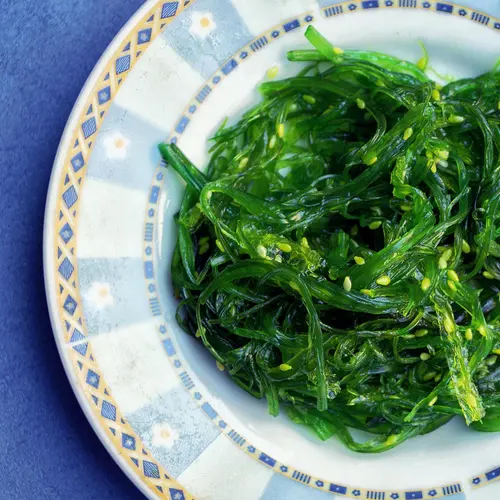Radicchio is a leafy vegetable with dark reddish-purple leaves and white veins. It’s sometimes called red chicory, Italian chicory, or red endive. It’s common in Italian and Mediterranean cooking.
While radicchio is sometimes mistaken for red cabbage or lettuce, it has a distinctively tangy or bitter taste, which can add a nice contrast and crunch to salads and other dishes. This versatile vegetable contains multiple key nutrients and has numerous health benefits, making it worth adding to your diet.
Health Benefits
Radicchio is a powerhouse of vitamins, minerals, and nutrients that provide essential health benefits. This leafy vegetable is low in calories, low-sodium, fat-free, and cholesterol-free, making it a healthy addition to your diet. Radicchio also may help with weight loss since it’s a good source of the dietary fiber inulin — a type of soluble fiber found in many plants.
Radicchio also can provide other health benefits like improved:
Cognitive Health in Older Adults
Radicchio is high in vitamin K, which is an important nutrient for healthy bodies and brains. Vitamin K may have a role in cognition, especially as people age. One study found that older adults with Alzheimer's disease consumed less vitamin K than their peers did. Another study suggests higher levels of vitamin K may be associated with better memory performance in healthy older adults.
Heart Health
The vitamin K in radicchio may help with heart health by preventing minerals from building up in arteries, so blood can flow freely. Because vitamin K supports the body’s blood clotting functions, it can be particularly helpful for people taking blood thinners. It also contains phytonutrients that help regulate blood pressure and inulin, which may help reduce the risk of cardiovascular diseases.
Bone Health
Radicchio also may support bone health since vitamin K helps promote and regulate calcium in your body. Studies suggest people with high levels of vitamin K have higher bone densities, while those with low levels of vitamin K are at greater risk for osteoporosis.
Digestive Health
The antioxidants and fiber in radicchio may also help with digestive health. Antioxidants, like those found in radicchio, may help support intestinal health and contribute to repairing cell damage caused by oxidative stress. Diets high in fiber, like inulin found in radicchio, also can help the body’s digestive system by helping with bowel regularity.
Nutrition
Radicchio is rich in vitamin K, a good source of dietary fiber, and it contains antioxidants. These nutrients in radicchio help keep the body healthy and may help reduce the risk of health conditions such as cancer, diabetes, osteoporosis, and heart disease.
Radicchio also contains other vitamins and minerals in small amounts such as:
- Vitamin C
- Vitamin B6
- Vitamin E
- Calcium
- Magnesium
- Zinc
- Copper
- Iron
- Potassium
- Phosphorus
- Selenium
Nutrients per Serving
A one-cup (40g) serving of shredded radicchio contains:
- Calories: 9.2
- Protein: 0.6 grams
- Fat: 0.1 grams
- Carbohydrates: 1.8 grams
- Fiber: 0.4 grams
- Sugar: 0.2 grams
Things to Watch Out For
Radicchio makes a healthy addition to almost any diet. Its high water content, dietary fiber, and low calorie content help fill you up. It can be added to dishes in smaller amounts like salads and pasta dishes or used as a side dish.
In general, radicchio is safe to eat, but there are some side effects to watch out for. Like all foods, it’s possible to experience an allergic reaction to radicchio. If it’s your first time trying it, watch out for swelling or itching in your mouth or throat.
People prone to gallstones should also avoid radicchio as it can stimulate the production of bile. However, since this study used rodents, more research is needed to understand the effects on humans. Additionally, radicchio may lower blood sugar in people with diabetes or who are recovering from surgery.
How to Prepare Radicchio
There are many ways to prepare radicchio. Radicchio is often served raw, but it can also be grilled, sauteed, and more. When cooked, the flavor typically tastes more mellow and less bitter.
When selecting radicchio, the leaves should have a bright color, no browning, and feel firm. Store it in the refrigerator, ideally wrapped in plastic to keep it fresh. If you wash it before storing, try placing a paper towel in the storage container to absorb any extra moisture, so it stays crunchy. Overall, radicchio will stay fresh three to five days.
Here are some ways to use radicchio in recipes:
- Chop up radicchio leaves and add to salads
- Grill radicchio in wedges and serve as a side dish
- Roast radicchio with a balsamic vinegar
- Shred radicchio and serve as coleslaw either on its own or mixed with shredded cabbage
- Fill a radicchio leaf with tuna or chicken salad and eat like a wrap
- Fry radicchio with olive oil, garlic, and salt to taste
- Add radicchio to a stir fry
- Add radicchio to soups, stews, and pasta dishes
- Add radicchio to a white bean salad to add crunch and color

